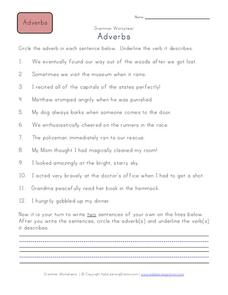Curated OER
The Passive Voice in Spanish
The passive voice was mastered by Spanish learners. Your class members can find out all about how to create the passive voice in Spanish using ser, past participles, por, and the impersonal se. Examples are provided for each situation.
Study Champs
Nouns
Plural, proper, and common nouns are all included here. After reviewing the definition of a noun and reading an example sentence, learners underline the nouns in each of 15 sentences. Each sentence lists how many nouns are present, so...
Curated OER
Fifth Grade Grammar Sentence Construction
In this grammar and sentences review worksheet, 5th graders recall comma usage, parts of speech, types of sentences, punctuation marks, run-on sentences, and sentences and sentence fragments. Students write 25 answers.
Curated OER
Grammar Skills
In this language arts worksheets, students will study word charts of adjectives. Students will focus on various uses of adjectives including qualifiers, observation, size, and description words.
Curated OER
Commas With Conjunctions Worksheet
In this grammar worksheet, learners complete a variety of activities including identifying whether sentences are correct or have a comma splice, correct comma splices in sentences and insert a comma to combine two sentences or more for...
Curated OER
Verb Practice Exercise
In this grammar worksheet, students identify the underlined part of speech in twenty sentences as a transitive verb, intransitive verb, linking verb or an auxiliary verb.
Curated OER
Florida Citrus Fruits
In this multiple skills worksheet about citrus fruits from Florida, learners use letters and letter clusters to fill in blanks and write picture words, trace and write words, write nouns, verbs, and adjectives and use them to create...
Curated OER
Prepositions
In this grammar activity, students learn about using prepositions in sentence writing. They then answer 12 questions regarding prepositions. The answers are on the last page of the packet.
EngageNY
Mid-Unit 3 Assessment, Part I: Short Constructed Response and Organizing Notes for a Public Speech
It's time to put pen to paper. Scholars complete the first part of the mid-unit 3 assessment, writing a short constructed response about international aid following a natural disaster. Next, pupils use informational texts and note...
Curated OER
Sentence Patterns II: Locating Objects and Complements
What sets this worksheet apart are the clear, concise explanations for some rather complex grammatical terms. Object complements, subject complements, transitive and intransitive verbs, and direct and indirect objects are all carefully...
CK-12 Foundation
Commonsense Composition
Any teacher with common sense should use the perfect resource to improve composition skills. Perfect for flipped lessons and station rotation, the text details information about genres of writing with guiding questions for readers....
K12 Reader
Adventures with Alliteration! - Nouns
Create poetry with a instructional activity based on alliterative phrases. After reviewing ten nouns, kids add an adjective to each based on the first letter of the noun. They then rewrite five sentences to involve more alliteration.
Film English
Fear of Flying
A bird that's afraid of flying? See what happens to this character when it's time to fly south. Over the course of the instructional activity, pupils discuss fears in general, share their fears, make predictions about the film, and view...
Jen London
Julius Caesar Funeral Speech Essay Assignment
"Romans, countrymen, and lovers! Hear me for my cause." "Friends, Romans, countrymen, lend me your ears!" As part of a study of William Shakespeare's Julius Caesar, individuals as asked to compare the funeral speeches of Brutus and...
K12 Reader
Working with Adverbs
Encourage critical thinking with a grammar exercise that focuses on adverbs and adverbial phrases. Kids read the first parts of 16 sentences, then decide which question to answer (how, how much, where, or when) based on the context, and...
Lesson Plans
Analogy of the Cell Project
Intended to supplement your existing cell function and organelle lessons, pairs work together to develop a real-world analogy for cell structures. In addition to writing paragraphs about the comparison, each group will make a short...
K12 Reader
Adjective Synonyms
Practice identifying adjectives and using synonyms with one exercise! Learners find the adjective in each sentence and replace it with a synonym from the word bank when they rewrite the sentence.
Kids Learning Station
Adverbs
Modify different verbs with a worksheet about adverbs. Kids read 12 sentences and circle the adverbs in each, in addition to underlining the verb that they describe. Next, they write their own sentences and indicate the appropriate...
Kids Learning Station
Adjectives
Enhance your writing with describing words. After reading 12 simple sentences, learners circle the adjectives and underline the nouns they describe. Additionally, they write a few of their own sentences with adjectives at the bottom of...
K12 Reader
Pronouns and Antecedents
Practice the basics of pronoun-antecedent agreement by assigning this exercise. Class members identify both the pronoun and the antecedents in ten sentences.
Grammar Net
Past Simple v. Past Perfect Simple
Help English learners tell the difference between the past tense and the past perfect tense with a grammar worksheet. As kids read twelve sentences, they change the given verbs to the correct tense based on context clues.
Poetry4kids
How to Write an Alliteration Poem
Learners follow five steps to compose an alliteration poem. They choose one consonant and brainstorm as many nouns, verbs, and adjectives they can think of to create rhyming sentences that come together in a poetic fashion.
K12 Reader
Identifying Adverbs II
Investigate the impact and function of adverbs with a grammar worksheet. Kids look for the adverbs and adverbial phrases in 15 sentences, and then underline the verbs that the adverb modifies.
K12 Reader
Possessive Pronouns
It's mine! No, wait, it's yours! Have your class members practice possessive pronouns so they can properly name who an item belongs to. For this exercise, pupils choose the correct possessive pronouns to complete 12 sentences.























